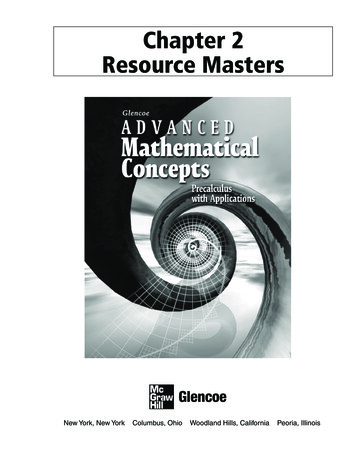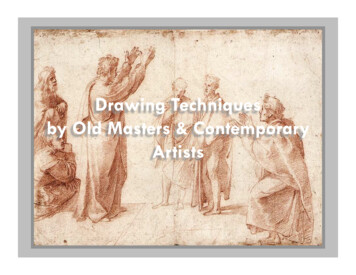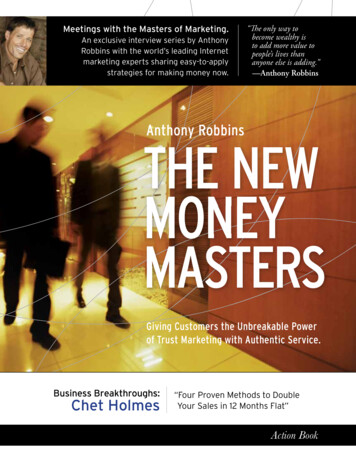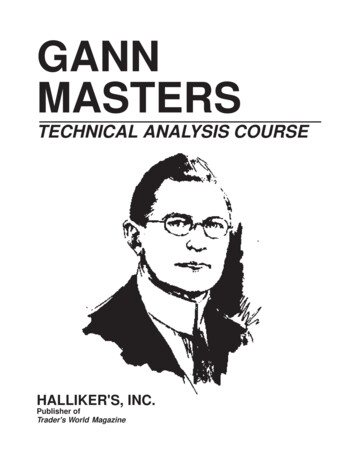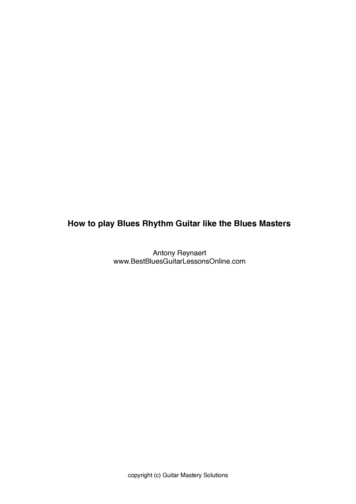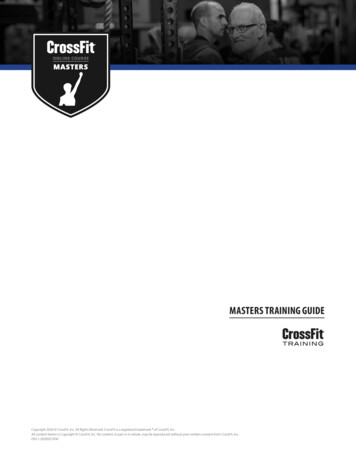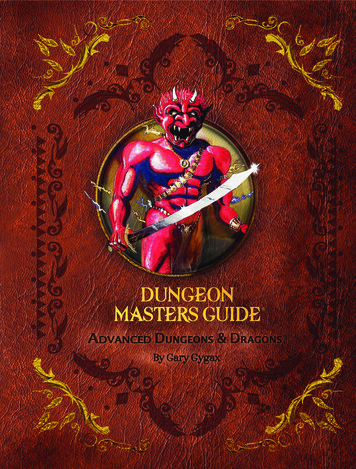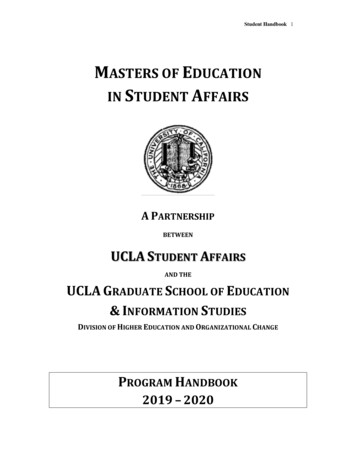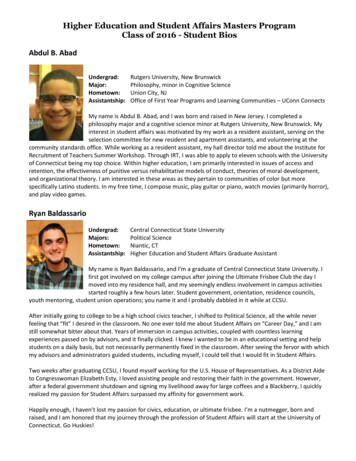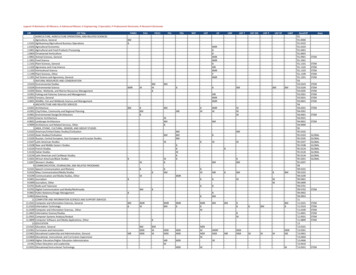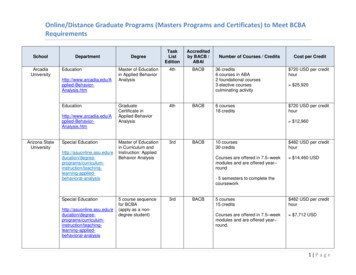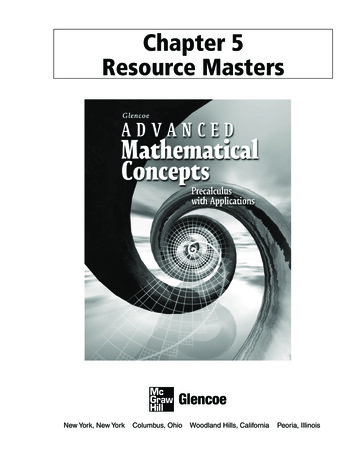
Transcription
Chapter 5Resource MastersNew York, New YorkColumbus, OhioWoodland Hills, CaliforniaPeoria, Illinois
StudentWorksTM This CD-ROM includes the entire Student Edition along with theStudy Guide, Practice, and Enrichment masters.TeacherWorksTM All of the materials found in this booklet are included for viewingand printing in the Advanced Mathematical Concepts TeacherWorksCD-ROM.Copyright The McGraw-Hill Companies, Inc. All rights reserved.Printed in the United States of America. Permission is granted to reproduce thematerial contained herein on the condition that such material be reproduced onlyfor classroom use; be provided to students, teachers, and families without charge;and be used solely in conjunction with Glencoe Advanced Mathematical Concepts.Any other reproduction, for use or sale, is prohibited without prior writtenpermission of the publisher.Send all inquiries to:Glencoe/McGraw-Hill8787 Orion PlaceColumbus, OH 43240-4027ISBN: 0-07-869132-X1 2 3 4 5 6 7 8 9 10Advanced Mathematical ConceptsChapter 5 Resource MastersXXX11 10 09 08 07 06 05 04
ContentsVocabulary Builder . . . . . . . . . . . . . . . . . vii-xLesson 5-7Study Guide . . . . . . . . . . . . . . . . . . . . . . . . . 199Practice . . . . . . . . . . . . . . . . . . . . . . . . . . . . . 200Enrichment . . . . . . . . . . . . . . . . . . . . . . . . . . 201Lesson 5-1Study Guide . . . . . . . . . . . . . . . . . . . . . . . . . 181Practice . . . . . . . . . . . . . . . . . . . . . . . . . . . . . 182Enrichment . . . . . . . . . . . . . . . . . . . . . . . . . . 183Lesson 5-8Study Guide . . . . . . . . . . . . . . . . . . . . . . . . . 202Practice . . . . . . . . . . . . . . . . . . . . . . . . . . . . . 203Enrichment . . . . . . . . . . . . . . . . . . . . . . . . . . 204Lesson 5-2Study Guide . . . . . . . . . . . . . . . . . . . . . . . . . 184Practice . . . . . . . . . . . . . . . . . . . . . . . . . . . . . 185Enrichment . . . . . . . . . . . . . . . . . . . . . . . . . . 186Chapter 5 AssessmentChapter 5 Test, Form 1A . . . . . . . . . . . . 205-206Chapter 5 Test, Form 1B . . . . . . . . . . . . 207-208Chapter 5 Test, Form 1C . . . . . . . . . . . . 209-210Chapter 5 Test, Form 2A . . . . . . . . . . . . 211-212Chapter 5 Test, Form 2B . . . . . . . . . . . . 213-214Chapter 5 Test, Form 2C . . . . . . . . . . . . 215-216Chapter 5 Extended ResponseAssessment . . . . . . . . . . . . . . . . . . . . . . . 217Chapter 5 Mid-Chapter Test . . . . . . . . . . . . . 218Chapter 5 Quizzes A & B . . . . . . . . . . . . . . . 219Chapter 5 Quizzes C & D. . . . . . . . . . . . . . . 220Chapter 5 SAT and ACT Practice . . . . . 221-222Chapter 5 Cumulative Review . . . . . . . . . . . 223Lesson 5-3Study Guide . . . . . . . . . . . . . . . . . . . . . . . . . 187Practice . . . . . . . . . . . . . . . . . . . . . . . . . . . . . 188Enrichment . . . . . . . . . . . . . . . . . . . . . . . . . . 189Lesson 5-4Study Guide . . . . . . . . . . . . . . . . . . . . . . . . . 190Practice . . . . . . . . . . . . . . . . . . . . . . . . . . . . . 191Enrichment . . . . . . . . . . . . . . . . . . . . . . . . . . 192Lesson 5-5Study Guide . . . . . . . . . . . . . . . . . . . . . . . . . 193Practice . . . . . . . . . . . . . . . . . . . . . . . . . . . . . 194Enrichment . . . . . . . . . . . . . . . . . . . . . . . . . . 195SAT and ACT Practice Answer Sheet,10 Questions . . . . . . . . . . . . . . . . . . . . . . . A1SAT and ACT Practice Answer Sheet,20 Questions . . . . . . . . . . . . . . . . . . . . . . . A2ANSWERS . . . . . . . . . . . . . . . . . . . . . . A3-A17Lesson 5-6Study Guide . . . . . . . . . . . . . . . . . . . . . . . . . 196Practice . . . . . . . . . . . . . . . . . . . . . . . . . . . . . 197Enrichment . . . . . . . . . . . . . . . . . . . . . . . . . . 198 Glencoe/McGraw-HilliiiAdvanced Mathematical Concepts
A Teacher’s Guide to Using theChapter 5 Resource MastersThe Fast File Chapter Resource system allows you to conveniently file theresources you use most often. The Chapter 5 Resource Masters include the corematerials needed for Chapter 5. These materials include worksheets, extensions,and assessment options. The answers for these pages appear at the back of thisbooklet.All of the materials found in this booklet are included for viewing and printing inthe Advanced Mathematical Concepts TeacherWorks CD-ROM.Vocabulary Builder Pages vii-x include aPractice There is one master for each lesson.student study tool that presents the keyvocabulary terms from the chapter. Students areto record definitions and/or examples for eachterm. You may suggest that students highlight orstar the terms with which they are not familiar.These problems more closely follow thestructure of the Practice section of the StudentEdition exercises. These exercises are ofaverage difficulty.When to Use These provide additionalpractice options or may be used as homeworkfor second day teaching of the lesson.When to Use Give these pages to studentsbefore beginning Lesson 5-1. Remind them toadd definitions and examples as they completeeach lesson.Enrichment There is one master for eachlesson. These activities may extend the conceptsin the lesson, offer a historical or multiculturallook at the concepts, or widen students’perspectives on the mathematics they arelearning. These are not written exclusivelyfor honors students, but are accessible for usewith all levels of students.Study Guide There is one Study Guidemaster for each lesson.When to Use Use these masters asreteaching activities for students who needadditional reinforcement. These pages can alsobe used in conjunction with the Student Editionas an instructional tool for those students whohave been absent. Glencoe/McGraw-HillWhen to Use These may be used as extracredit, short-term projects, or as activities fordays when class periods are shortened.ivAdvanced Mathematical Concepts
Assessment OptionsIntermediate AssessmentThe assessment section of the Chapter 5Resources Masters offers a wide range ofassessment tools for intermediate and finalassessment. The following lists describe eachassessment master and its intended use.Chapter Tests Forms 1A, 1B, and 1C Form 1 tests containmultiple-choice questions. Form 1A isintended for use with honors-level students,Form 1B is intended for use with averagelevel students, and Form 1C is intended foruse with basic-level students. These testsare similar in format to offer comparabletesting situations.Forms 2A, 2B, and 2C Form 2 tests arecomposed of free-response questions. Form2A is intended for use with honors-levelstudents, Form 2B is intended for use withaverage-level students, and Form 2C isintended for use with basic-level students.These tests are similar in format to offercomparable testing situations.The Extended Response Assessmentincludes performance assessment tasks thatare suitable for all students. A scoringrubric is included for evaluation guidelines.Sample answers are providedfor assessment. Glencoe/McGraw-Hill Four free-response quizzes are included tooffer assessment at appropriate intervals inthe chapter. The SAT and ACT Practice offerscontinuing review of concepts in variousformats, which may appear on standardizedtests that they may encounter. This practiceincludes multiple-choice, quantitativecomparison, and grid-in questions. Bubblein and grid-in answer sections are providedon the master. The Cumulative Review provides studentsan opportunity to reinforce and retain skillsas they proceed through their study ofadvanced mathematics. It can also be usedas a test. The master includes free-responsequestions.AnswersAll of the above tests include a challengingBonus question. A Mid-Chapter Test provides an option toassess the first half of the chapter. It iscomposed of free-response questions.Continuing AssessmentChapter Assessments v Page A1 is an answer sheet for the SAT andACT Practice questions that appear in theStudent Edition on page 341. Page A2 is ananswer sheet for the SAT and ACT Practicemaster. These improve students’ familiaritywith the answer formats they mayencounter in test taking. The answers for the lesson-by-lessonmasters are provided as reduced pages withanswers appearing in red. Full-size answer keys are provided for theassessment options in this booklet.Advanced Mathematical Concepts
Chapter 5 Leveled WorksheetsGlencoe’s leveled worksheets are helpful for meeting the needs of everystudent in a variety of ways. These worksheets, many of which are foundin the FAST FILE Chapter Resource Masters, are shown in the chartbelow. Study Guide masters provide worked-out examples as well as practiceproblems. Each chapter’s Vocabulary Builder master provides students theopportunity to write out key concepts and definitions in their ownwords. Practice masters provide average-level problems for students whoare moving at a regular pace. Enrichment masters offer students the opportunity to extend theirlearning.Five Different Options to Meet the Needs ofEvery Student in a Variety of Waysprimarily skillsprimarily conceptsprimarily applicationsBASICAVERAGE1Study Guide2Vocabulary Builder3Parent and Student Study Guide (online) dvanced Mathematical Concepts
NAME DATE PERIODChapter5Reading to Learn MathematicsVocabulary BuilderThis is an alphabetical list of the key vocabulary terms you will learn in Chapter 5.As you study the chapter, complete each term’s definition or description.Remember to add the page number where you found the term.Vocabulary TermFoundon PageDefinition/Description/Exampleambiguous caseangle of depressionangle of elevationapothemarccosine relationarcsine relationarctangent relationcircular functioncofunctionscosecant(continued on the next page) Glencoe/McGraw-HillviiAdvanced Mathematical Concepts
NAME DATE PERIODChapter5Reading to Learn MathematicsVocabulary Builder (continued)Vocabulary TermFoundon oterminal anglesdegreeHero’s Formulahypotenuseinitial sideinverseLaw of CosinesLaw of Sinesleg(continued on the next page) Glencoe/McGraw-HillviiiAdvanced Mathematical Concepts
NAME DATE PERIODChapter35Reading to Learn MathematicsVocabulary Builder (continued)Vocabulary TermFoundon PageDefinition/Description/Exampleminutequadrant anglereference anglesecantsecondside adjacentside oppositesinesolve a trianglestandard positiontangent(continued on the next page) Glencoe/McGraw-HillixAdvanced Mathematical Concepts
NAME DATE PERIODChapter5Reading to Learn MathematicsVocabulary Builder (continued)Vocabulary TermFoundon PageDefinition/Description/Exampleterminal sidetrigonometric functiontrigonometric ratiounit circlevertex Glencoe/McGraw-HillxAdvanced Mathematical Concepts
NAME DATE PERIOD5-1Study GuideAngles and Degree MeasureDecimal degree measures can be expressed in degrees( ),minutes(′), and seconds(″).Example 1a. Change 12.520 to degrees, minutes, andseconds.12.520 12 (0.520 60)′Multiply the decimal portion of 12 31.2′the degrees by 60 to find minutes. 12 31′ (0.2 60)″ Multiply the decimal portion of 12 31′ 12″the minutes by 60 to find seconds.12.520 can be written as 12 31′ 12″.b. Write 24 15′ 33″ as a decimal rounded to thenearest thousandth. 1 33″ 1 24 15′ 33″ 24 15′ 60′3600″ 24.259 24 15′ 33″ can be written as 24.259 .An angle may be generated by the rotation of one raymultiple times about the origin.Example 2Give the angle measure represented by eachrotation.a. 2.3 rotations clockwise2.3 360 828Clockwise rotations have negative measures.The angle measure of 2.3 clockwise rotations is 828 .b. 4.2 rotations counterclockwise4.2 360 1512Counterclockwise rotations have positivemeasures.The angle measure of 4.2 counterclockwise rotations is 1512 .If is a nonquadrantal angle in standard position, its referenceangle is defined as the acute angle formed by the terminal side ofthe given angle and the x-axis.ReferenceAngle RuleExample 3For any angle , 0 360 , its reference angle ′ is defined bya. , when the terminal side is in Quadrant I,b. 180 , when the terminal side is in Quadrant II,c. 180 , when the terminal side is in Quadrant III, andd. 360 , when the terminal side is in Quadrant IV.Find the measure of the reference angle for 220 .Because 220 is between 180 and 270 , theterminal side of the angle is in Quadrant III.220 180 40 The reference angle is 40 . Glencoe/McGraw-Hill181Advanced Mathematical Concepts
NAME DATE PERIOD5-1PracticeAngles and Degree MeasureChange each measure to degrees, minutes, and seconds.1. 28.955 2. 57.327 Write each measure as a decimal degree to the nearestthousandth.3. 32 28′ 10″4. 73 14′ 35″Give the angle measure represented by each rotation.5. 1.5 rotations clockwise6. 2.6 rotations counterclockwiseIdentify all angles that are coterminal with each angle. Then findone positive angle and one negative angle that are coterminalwith each angle.7. 43 8. 30 If each angle is in standard position, determine a coterminal anglethat is between 0 and 360 , and state the quadrant in which theterminal side lies.9. 472 10. 995 Find the measure of the reference angle for each angle.11. 227 12. 640 13. Navigation For an upcoming trip, Jackie plans to sail fromSanta Barbara Island, located at 33 28′ 32″ N, 119 2′ 7″ W, toSanta Catalina Island, located at 33.386 N, 118.430 W. Writethe latitude and longitude for Santa Barbara Island as decimalsto the nearest thousandth and the latitude and longitude forSanta Catalina Island as degrees, minutes, and seconds. Glencoe/McGraw-Hill182Advanced Mathematical Concepts
NAME DATE PERIOD5-1EnrichmentReading Mathematics: If and Only If StatementsIf p and q are interchanged in a conditional statement so that pbecomes the conclusion and q becomes the hypothesis, the new statement, q p, is called the converse of p q.If p q is true, q p may be either true or false.ExampleFind the converse of each conditional.a. p q: All squares are rectangles. (true)q p: All rectangles are squares. (false)b. p q: If a function ƒ(x) is increasing on aninterval I, then for every a and b contained inI, ƒ(a) ƒ(b) whenever a b. (true)q p: If for every a and b contained in an interval I,ƒ(a) ƒ(b) whenever a b then function ƒ(x) isincreasing on I. (true)In Lesson 3-5, you saw that the two statements in Example 2 can becombined in a single statement using the words “if and only if.”A function ƒ(x) is increasing on an interval I if and only if forevery a and b contained in I, ƒ(a) ƒ(b) whenever a b.The statement “p if and only if q” means that p implies q andq implies p.State the converse of each conditional. Then tell if the converse istrue or false. If it is true, combine the statement and its converseinto a single statement using the words “if and only if.”1. All integers are rational numbers.2. If for all x in the domain of a function ƒ(x), ƒ( x) ƒ(x), thenthe graph of ƒ(x) is symmetric with respect to the origin.3. If ƒ(x) and ƒ 1(x) are inverse functions, then [ ƒ ƒ 1](x) [ ƒ 1 ƒ](x) x. Glencoe/McGraw-Hill183Advanced Mathematical Concepts
NAME DATE PERIOD5-2Study GuideTrigonometric Ratios in Right TrianglesThe ratios of the sides of right triangles can be used to definethe trigonometric ratios known as the sine, cosine, andtangent.Example 1Find the values of the sine, cosine, and tangentfor A. .First find the length of BC222(AC) (BC) (AB)Pythagorean Theorem22210 (BC) 20Substitute 10 for AC and 20 for AB.2(BC) 300BC 3 0 0 or 10 3 Take the square root of each side.Disregard the negative root.Then write each trigonometric ratio.side opposite sin A hypotenuseside adjacent cos A hypotenuseside opposite tan A side adjacent10 3 or 30 or 1 10 3 or 3 sin A cos A 12 tan A 2020102Trigonometric ratios are often simplified but never written asmixed numbers.Three other trigonometric ratios, called cosecant, secant,and cotangent, are reciprocals of sine, cosine, and tangent,respectively.Example 2Find the values of the six trigonometricratios for R.First determine the length of the hypotenuse.Pythagorean Theorem(RT)2 (ST)2 (RS)2222RT 15, ST 315 3 (RS)2(RS) 234RS 2 3 4 or 3 2 6 Disregard the negative root.side oppositeside adjacentside opposite sin R hypotenuse cos R hypotenuse 62 sin R 3 or 263 2 6 5 2 6 tan R 3 or 1 cos R 15 or 261553 2 6hypotenusehypotenuse tan R side adjacentside adjacent csc R side opposite sec R side adjacent cot R side opposite3 62 or 2csc R 6 33 2 6 or 62 sec R 1555 or 5cot R 13 Glencoe/McGraw-Hill184Advanced Mathematical Concepts
NAME DATE PERIOD5-2PracticeTrigonometric Ratios in Right TrianglesFind the values of the sine, cosine, and tangent for each B.1.2.3. If tan 5, find cot .4. If sin 38 , find csc .Find the values of the six trigonometric ratios for each S.5.6.7. Physics Suppose you are traveling in a car when a beam of lightpasses from the air to the windshield. The measure of the angleof incidence is 55 , and the measure of the angle of refraction issin i n, to find the index of refraction n35 15′. Use Snell’s Law, sin rof the windshield to the nearest thousandth. Glencoe/McGraw-Hill185Advanced Mathematical Concepts
NAME DATE PERIOD5-2EnrichmentUsing Right Triangles to Find the Area ofAnother TriangleYou can find the area of a right triangle by using the formulaA 1 bh.2In the formula, one leg of the right triangle can be used asthe base, and the other leg can be used as the height.The vertices of a triangle can be represented on the coordinate planeby three ordered pairs. In order to find the area of a general triangle,you can encase the triangle in a rectangle as shown in the diagrambelow.A rectangle is placed around the triangle so that the vertices of thetriangle all touch the sides of the rectangle.ExampleFind the area of a triangle whose vertices areA( 1, 3), B(4, 8), and C(8, 5).Plot the points and draw the triangle. Encase the trianglein a rectangle whose sides are parallel to theaxes, then find the coordinates of the vertices of therectangle.Area ABC area ADEF area ADB area BEC area CFA, where ADB, BEC,and CFA are all right triangles.Area ABC 5(9) 1 (5)(5)2 1 (4)(3)2 1 (2)(9)2 17.5 square unitsFind the area of the triangle having vertices with each set of coordinates.1. A(4, 6), B(–1, 2), C(6, –5)2. A(–2, –4), B(4, 7), C(6, –1)3. A(4, 2), B(6, 9), C(–1, 4)4. A(2, –3), B(6, –8), C(3, 5) Glencoe/McGraw-Hill186Advanced Mathematical Concepts
NAME DATE PERIOD5-3Study GuideTrigonometric Functions on the Unit CircleExample 1Use the unit circle to find cot ( 270 ).The terminal side of a 270 angle instandard position is the positive y-axis,which intersects the unit circle at (0, 1).By definition, cot ( 270 ) xy or 01 .Therefore, cot ( 270 ) 0.TrigonometricFunctions ofan Angle inStandard Positionysin rrcsc ycos x tan y xxxcot yrrsec Example 2 Find the values of the six trigonometric functionsfor angle in standard position if a point withcoordinates ( 9, 12) lies on its terminal side.We know that x 9 and y 12. We need tofind r.Example 3 y2 r x 2 Pythagorean Theoremr ( 9 )2 21 2 Substitute 9 for x and 12 for y.r 2 2 5 or 15Disregard the negative root.sin 1125 or 45 9 or 3 cos 15512 or 4 tan 3 9csc 1152 or 54 15 or 5 sec 3 9 9 or 3 cot 124Suppose is an angle in standard position whoseterminal side lies in Quadrant I. If cos 35 , findthe values of the remaining five trigonometricfunctions of .r2 x2 y252 32 y216 y24 yPythagorean TheoremSubstitute 5 for r and 3 for x.Take the square root of each side.Since the terminal side of lies in Quadrant I, y mustbe positive.sin 45 csc 54 Glencoe/McGraw-Hilltan 43 sec 35 187cot 34 Advanced Mathematical Concepts
NAME DATE PERIOD5-3PracticeTrigonometric Functions on the Unit CircleUse the unit circle to find each value.1. csc 90 2. tan 270 3. sin ( 90 )Use the unit circle to find the values of the six trigonometricfunctions for each angle.4. 45 5. 120 Find the values of the six trigonometric functions for angle instandard position if a point with the given coordinates lies on itsterminal side.6. ( 1, 5)7. (7, 0)8. ( 3, 4) Glencoe/McGraw-Hill188Advanced Mathematical Concepts
NAME DATE PERIOD5-3EnrichmentAreas of Polygons and CirclesA regular polygon has sides of equal length and angles of equalmeasure. A regular polygon can be inscribed in or circumscribedabout a circle. For n-sided regular polygons, the following areaformulas can be used.AC r2Area of circlenr2 2 sin360 nArea of circumscribed polygon AC nr2 tan180 nArea of inscribed polygonAI Use a calculator to complete the chart below for a unit circle (a circle of radius 1).Numberof SidesArea ofInscribedPolygonArea of CirclelessArea of PolygonArea ofCircumscribedPolygonArea of PolygonlessArea of .124.205.246.287.328.10009. What number do the areas of the circumscribed and inscribedpolygons seem to be approaching as the number of sides of thepolygon increases? Glencoe/McGraw-Hill189Advanced Mathematical Concepts
NAME DATE PERIOD5-4Study GuideApplying Trigonometric FunctionsTrigonometric functions can be used to solve problemsinvolving right triangles.Example 1If T 45 and u 20, find t to the nearest tenth.From the figure, we know the measures of anangle and the hypotenuse. We want to know themeasure of the side opposite the given angle. Thesine function relates the side opposite the angleand the hypotenuse.sin T ut sin 45 2t0 20 sin 45 t14.14213562 tside opposite sin hypotenuseSubstitute 45 for T and 20 for u.Multiply each side by 20.Use a calculator.Therefore, t is about 14.1.Example 2Geometry The apothem of a regular polygon is themeasure of a line segment from the center of thepolygon to the midpoint of one of its sides. Theapothem of a regular hexagon is 2.6 centimeters.Find the radius of the circle circumscribed aboutthe hexagon to the nearest tenth.First draw a diagram. Let a be the anglemeasure formed by a radius and its adjacentapothem. The measure of a is 360 12 or30 . Now we know the measures of an angleand the side adjacent to the angle.2.6 cos 30 rr cos 30 2.6side adjacent cos hypotenuseMultiply each side by r.2. 6Divide each side by cos 30 .r cos 30 r 3.0022214Use a calculator.Therefore, the radius is about 3.0 centimeters. Glencoe/McGraw-Hill190Advanced Mathematical Concepts
NAME DATE PERIOD5-4PracticeApplying Trigonometric FunctionsSolve each problem. Round to the nearest tenth.1. If A 55 55′ and c 16, find a.2. If a 9 and B 49 , find b.3. If B 56 48′ and c 63.1, find b.4. If B 64 and b 19.2, find a.5. If b 14 and A 16 , find c.6. Construction A 30-foot ladder leaning againstthe side of a house makes a 70 5′ angle with theground.a. How far up the side of the house does theladder reach?b. What is the horizontal distance between thebottom of the ladder and the house?7. Geometry A circle is circumscribed about a regular hexagon with anapothem of 4.8 centimeters.a. Find the radius of the circumscribed circle.b. What is the length of a side of the hexagon?c. What is the perimeter of the hexagon?8. Observation A person standing 100 feet from the bottomof a cliff notices a tower on top of the cliff. The angle ofelevation to the top of the cliff is 30 . The angle of elevationto the top of the tower is 58 . How tall is the tower? Glencoe/McGraw-Hill191Advanced Mathematical Concepts
NAME DATE PERIOD5-4EnrichmentMaking and Using a HypsometerA hypsometer is a device that can be used to measure the height ofan object. To construct your own hypsometer, you will need arectangular piece of heavy cardboard that is at least 7 cm by 10 cm,a straw, transparent tape, a string about 20 cm long, and a smallweight that can be attached to the string.Mark off 1-cm increments along one short side and one long side ofthe cardboard. Tape the straw to the other short side. Then attachthe weight to one end of the string, and attach the other end of thestring to one corner of the cardboard, as shown in the figure below.The diagram below shows how your hypsometer should look.To use the hypsometer, you will need to measure the distance fromthe base of the object whose height you are finding to where youstand when you use the hypsometer.Sight the top of the object through the straw. Note where the freehanging string crosses the bottom scale. Then use similar trianglesto find the height of the object.1. Draw a diagram to illustrate how you can use similar trianglesand the hypsometer to find the height of a tall object.Use your hypsometer to find the height of each of the following.2. your school’s flagpole3. a tree on your school’s property4. the highest point on the front wall of your school building5. the goal posts on a football field6. the hoop on a basketball court7. the top of the highest window of your school building8. the top of a school bus9. the top of a set of bleachers at your school10. the top of a utility pole near your school Glencoe/McGraw-Hill192Advanced Mathematical Concepts
NAME DATE PERIOD5-5Study GuideSolving Right TrianglesWhen we know a trigonometric value of an angle but not thevalue of the angle, we need to use the inverse of thetrigonometric function.Trigonometric Functiony sin xy cos xy tan xExample 1Inverse Trigonometric Relationx sin 1 y or x arcsin yx cos 1 y or x arccos yx tan 1 y or x arctan y .Solve tan x 3If tan x 3 , then x is an angle whose tangent .is 3x arctan 3 From a table of values, you can determine thatx equals 60 , 240 , or any angle coterminal withthese angles.Example 2If c 22 and b 12, find B.In this problem, we know the side opposite theangle and the hypotenuse. The sine functionrelates the side opposite the angle and thehypotenuse.side oppositesin B bc sin hypotenusesin B 1222 Substitute 12 for b and 22 for c.B sin 1 1222 Definition of inverseB 33.05573115 or about 33.1 .Example 3Solve the triangle where b 20 and c 35, giventhe triangle above.cos A bc 2 0cos A 35a2 b2 c2a2 202 352a 8 2 5 a 28.7228132320 A cos-1 35 A 55.1500954255.15009542 B 90B 34.84990458Therefore, a 28.7, A 55.2 , and B 34.8 . Glencoe/McGraw-Hill193Advanced Mathematical Concepts
NAME DATE PERIOD5-5PracticeSolving Right TrianglesSolve each equation if 0 x 360 . 2 1. cos x 2 2. tan x 113. sin x 2 Evaluate each expression. Assume that all angles are in Quadrant I. 34. tan tan 1 35. tan cos 1 23 6. cos arcsin 15 3 Solve each problem. Round to the nearest tenth.7. If q 10 and s 3, find S.8. If r 12 and s 4, find R.9. If q 20 and r 15, find S.Solve each triangle described, given the triangle at the right.Round to the nearest tenth, if necessary.10. a 9, B 49 11. A 16 , c 1412. a 2, b 713. Recreation The swimming pool at Perris Hill Plunge is 50 feetlong and 25 feet wide. The bottom of the pool is slanted so thatthe water depth is 3 feet at the shallow end and 15 feet at thedeep end. What is the angle of elevation at the bottom of thepool? Glencoe/McGraw-Hill194Advanced Mathematical Concepts
NAME DATE PERIOD5-5EnrichmentDisproving Angle TrisectionMost geometry texts state that it is impossible to trisect an arbitraryangle using only a compass and straightedge. This fact has beenknown since ancient times, but since it is usually stated withoutproof, some geometry students do not believe it. If the students setout to find a method for trisecting angles, they will probably try thefollowing method. It is based on the familiar construction whichallows a segment to be divided into any desired number of congruentsegments. You can use inverse trigonometric functions to show thatapplication of the method to the trisection of angles is not valid.Given: AClaim: A can be trisected using the following method.Method: Choose point C on one ray of A .Through C construct a perpendicular tothe other ray, intersecting it at B.Construct M and N, the points that into three congruentdivide CBsegments. Draw A M and AN , whichtrisect CAB into the congruent angles 1, 2, and 3.The proposed method has been used to construct the figure below.CM MN NB 1. AB 5. Follow the instructions to show thatthe three angles 1, 2, and 3, are not congruent. Find anglemeasures to the nearest tenth of a degree.1. Express m 3 as the value of an inverse function.2. Find the measure of 3.3. Write m MAB as the value of an inverse function.4. Find the measure of MAB.5. Find the measure of 2.6. Find m CAB and use it to find m 1.7. Explain why the proposed method for trisecting an angle fails. Glencoe/McGraw-Hill195Advanced Mathematical Concepts
NAME DATE
the Advanced Mathematical Concepts TeacherWorks CD-ROM. Vocabulary Builder Pages vii-x include a student study tool that presents the key vocabulary terms from the chapter. Students are to record definitions and/or examples for each term. You may suggest that students high
